
The CASA C-212 Aviocar is a turboprop-powered STOL medium cargo aircraft designed and built by CASA in Spain for civil and military use.
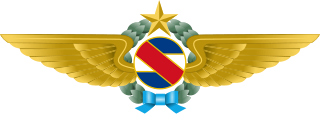
The Uruguayan Air Force is the air branch of the Uruguayan Armed Forces. Initially part of the National Army, the current FAU was formed as an independent branch on December 4, 1953.
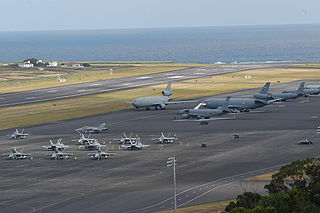
Lajes Field or Lajes Air Base, officially designated Air Base No. 4, is a multi-use airfield, home to the Portuguese Air Force Base Aérea N º4 and Azores Air Zone Command, a United States Air Force detachment unit, and a regional air passenger terminal located near Lajes and 15 km (9.3 mi) northeast of Angra do Heroísmo on Terceira Island in the Azores, Portugal. Located about 3,680 km (2,290 mi) east of New York City and about 1,600 km (990 mi) west of Lisbon, Portugal; the base sits in a strategic location midway between North America and Europe in the north Atlantic Ocean.

The Portuguese Air Force is the aerial warfare force of Portugal. Locally it is referred to by the acronym FAP but internationally is often referred to by the acronym PoAF. It is the youngest of the three branches of the Portuguese Armed Forces.
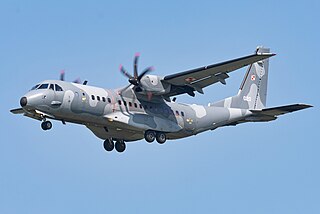
The CASA C-295 is a medium tactical transport aircraft that was designed by the Spanish company CASA in the 1990s as a development of the CASA-Nurtanio CN-235. When CASA was incorporated into the European aeronautical group EADS in 2000, the aircraft was designated as the EADS CASA C-295. It made its first flight on 28 November 1997 and entered service with the Spanish Air Force in 2001.

The 711 Squadron "Albatrozes" was a flying squadron of the Portuguese Air Force. Its primary mission was Search and Rescue and it has had secondary missions tactical air transport and general air transport in the Azores archipelago. During the time it was active it was the only operational squadron in the Portuguese military to operate both rotary- and fixed-wing aircraft.

201 Squadron "Falcões" is a fighter squadron of the Portuguese Air Force, operating the F-16 Fighting Falcon.
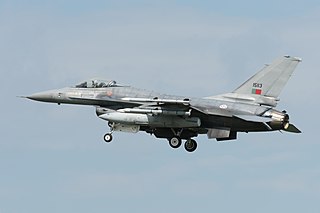
The 301 Squadron "Jaguares" is a fighter squadron of the Portuguese Air Force (PoAF).
Sevenair SA, formerly branded Aero VIP, is a Portuguese regional airline headquartered in Cascais Aerodrome, western Lisbon. It operates domestic regional routes within mainland Portugal and also offers additional aviation services and non-scheduled operations in third countries. It is part of Sevenair Group, one of the biggest aeronautical groups operating in Portugal, which provides the following services: air transportation, aerial works, flying school, and aircraft maintenance.
Mexican Naval Aviation, is the naval air arm of the Mexican Navy. The Mexican Navy is divided into two naval fleets: Pacific Ocean and Gulf of Mexico.
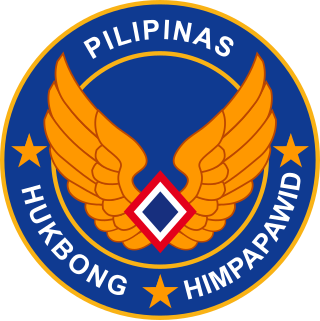
The Philippine Air Force is the aerial warfare service branch of the Armed Forces of the Philippines. Initially formed as part of the Philippine Army, the PAF is responsible for both defending the Philippine airspace, and conducting aerial operations throughout the Philippines, such as close air support operations, combat air patrols, aerial reconnaissance missions, airlift operations, helicopter tactical operations and aerial humanitarian operations. The PAF is headquartered at the Villamor Air Base in Pasay, and is headed by the Chief of the Air Force, who also serves as the branch's highest-raking military officer.
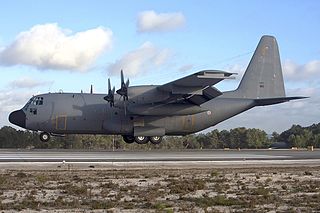
The 501 Squadron "Bisontes" is a transport squadron of the Portuguese Air Force.

The 502 Squadron "Elefantes" is a transport squadron of the Portuguese Air Force. Its primary mission is tactical air transport and has the secondary mission of providing additional pilot training in multi-engine aircraft and in navigation, search and rescue, and general air transport.

552 Squadron "Zangões" is a transport helicopter squadron of the Portuguese Air Force (PoAF). Its based at Air Base No. 11, at Beja, and operates the AgustaWestland AW119 in transport and helicopter instruction roles. It also operates the 3 Allouete III forma special mission, aerocrobatic team.

601 Squadron "Lobos" is a maritime patrol and anti-submarine warfare squadron of the Portuguese Air Force (PoAF), currently based at Beja Air Base. It operates the Lockheed P-3C CUP+ Orion.

Sintra Air Base, officially designated as Air Base No. 1, is a Portuguese Air Force base located in the Sintra Municipality, Portugal. The base is home to a flight training squadron and the Portuguese Air Force Academy.

102 Squadron "Panchos" was an elementary flight training squadron of the Portuguese Air Force disbanded in 1992. Formed in 1962, the squadron administered air force training and performed at air shows throughout Portugal. Between 1963 and its disbandment in 1992, the squadron lost nine pilots.
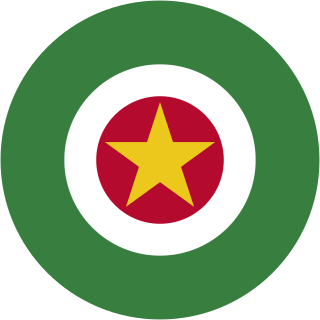
The Suriname Air Force is the air component of the Military of Suriname. All aircraft of the Suriname Air Force undertake border patrols, utility transport, and search and rescue missions from Zorg en Hoop Airport, the Air Force's main base. Aircraft are occasionally transferred to other air bases in the nation, which include Johan Adolf Pengel International Airport, Major Fernandes Airfield, Albina Airstrip, and Moengo Airstrip. The head of the Suriname Air Force is the Commander of the Air Force, currently Lieutenant Colonel Marven van Huisduinen, who took over the role in March 2019 from former Commander Robert Kartodikromo. The Air Force is further split into several wings, including the Helicopter Wing, the current Commander of which being Captain John-Marc Arron.

















